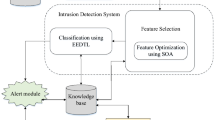Abstract
Cloud computing (CC) emerged as one of the important utility such as water and electricity bills, where the user has to pay for whatever quantity they have utilized for their tasks. As cloud users are increasing; so the crucial challenges for the cloud service provider (CSP) is to balance the load among the resources shared by the end-users and curb increased security risks, misuse, or malicious attacks in cloud computing. The functionality of load balancing is divided into two functions, first, there will be allocation of resources and the second is the provisioning of resources along with task scheduling in the distributed system such as CC. Although many state-of-the-art approaches are available in the literature which provides load balancing and better resource utilization. In this paper, we build a dynamic prediction approach for cloud resource usage, discuss a load balancing technique, and identify sudden spikes and failures that are causes of the anomaly using a reactive and proactive approach. The final result demonstrates a comparative analysis of deep learning models for the prediction of cloud resource utilization, insight into dynamic load balancing technique and anomaly detection.
Access this chapter
Tax calculation will be finalised at checkout
Purchases are for personal use only
Similar content being viewed by others
References
Al Nuaimi K, Mohamed N, Al Nuaimi M, Al-Jaroodi J (2012) A survey of load balancing in cloud computing: Challenges and algorithms. In: 2012 second symposium on network cloud computing and applications, IEEE, pp 137–142
Deepa T, Cheelu D (2017) A comparative study of static and dynamic load balancing algorithms in cloud computing. In: 2017 International conference on energy, communication, data analytics and soft computing (ICECDS), IEEE, pp 3375–3378
Prasad VK, Bhavsar M (2017) Exhausting autonomic techniques for meticulous consumption of resources at an IaaS layer of cloud computing. In: International conference on future internet technologies and trends, Springer, pp 37–46
Dashti SE, Rahmani AM (2016) Dynamic vms placement for energy efficiency by psoin cloud computing. J Exp Theor Artif Intell 28(1–2):97–112
Prasad VK, Bhavsar MD (2020) Monitoring IaaS cloud for healthcare systems: healthcare information management and cloud resources utilization. Int J E-Health Med Commun (IJEHMC) 11(3):54–70
Ramachandra G, Iftikhar M, Khan FA (2017) A comprehensive survey on security in cloud computing. Procedia Comput Sci 110:465–472
Prasad VK, Bhavsar M (2017) Efficient resource monitoring and prediction techniques in an IaaS level of cloud computing: survey. In: International conference on future internet technologies and trends, Springer, pp 47–55
Prasad VK, Bhavsar MD (2021) SLAMMP framework for cloud resource management and its impact on healthcare computational techniques. Int J E-Health Med Commun (IJEHMC) 12(2):1–31
Wang P, Lei Y, Agbedanu PR, Zhang Z (2020) Makespan-driven workflow scheduling in clouds using immune-based PSO algorithm. IEEE Access 8:29281–29290
Chen Z, Hu J, Min G, Zomaya AY, El-Ghazawi T (2019) Towards accurate prediction for high-dimensional and highly-variable cloud workloads with deep learning. IEEE Trans Parallel Distrib Syst 31(4):923–934
Luong NC, Wang P, Niyato D, Wen Y, Han Z (2017) Resource management in cloud networking using economic analysis and pricing models: A survey. IEEE Commun Surv Tutorials 19(2):954–1001
Prasad VK, Bhavsar M (2019) Preserving SLA parameters for trusted IaaS cloud: an intelligent monitoring approach. Recent Patents Eng 13(1)
Prasad VK, Bhavsar MD (2020) Monitoring and prediction of SLA for IOT based cloud. Scalable Comput: Pract Experience 21(3):349–358
Al-Maamari A, Omara FA (2015) Task scheduling using pso algorithm in cloud computing environments. Int J Grid Distrib Comput 8(5):245–256
Shekhar S, Gokhale A (2017) Dynamic resource management across cloud-edge resources for performance-sensitive applications. In: 2017 17th IEEE/ACM international symposium on cluster, cloud and grid computing (CCGRID), IEEE, pp 707–710
Kumar J, Goomer R, Singh AK (2018) Long short term memory recurrent neural network (lstm-rnn) based workload forecasting model for cloud data centers. Procedia Comput Sci 125:676–682
Author information
Authors and Affiliations
Corresponding author
Editor information
Editors and Affiliations
Rights and permissions
Copyright information
© 2022 The Author(s), under exclusive license to Springer Nature Singapore Pte Ltd.
About this paper
Cite this paper
Bakshi, M.S., Banker, D., Prasad, V., Bhavsar, M. (2022). SMLHADC: Security Model for Load Harmonization and Anomaly Detection in Cloud. In: Dahal, K., Giri, D., Neogy, S., Dutta, S., Kumar, S. (eds) Internet of Things and Its Applications. Lecture Notes in Electrical Engineering, vol 825. Springer, Singapore. https://doi.org/10.1007/978-981-16-7637-6_36
Download citation
DOI: https://doi.org/10.1007/978-981-16-7637-6_36
Published:
Publisher Name: Springer, Singapore
Print ISBN: 978-981-16-7636-9
Online ISBN: 978-981-16-7637-6
eBook Packages: EngineeringEngineering (R0)




